|
|
|||
|
THIS WEEK at HILTON POND Back to Preceding Week; on to Next Week |
EBONY AND IVORY:
BLACKBIRDS IN THE SNOW After a far-too-mild November and December, the new year arrived with a relative vengeance, dumping eight inches of snow on Hilton Pond Center on 2-4 January 2002. There's seldom a winter when we don't get at least a one- or two-inch snowfall, but anytime there's more than half a foot of white stuff it qualifies as a major weather event. Across the Carolina Piedmont kids and teachers were out of school, businesses opened late--if at all, and even churches called off their activities. Such is life in a region where it just doesn't pay to buy lots of snow removal equipment that only gets used once or twice a year.
All photos & text © Hilton Pond Center Like us humans, the local birds seemed taken aback by all the fluffy, frozen precipitation that nestled down on tree limbs and open fields. As the snow continued to fall, birds swarmed to the Center in greater numbers than we have seen in several years. There were dozens of Cedar Waxwings competing with Eastern Bluebirds for the last berries of Flowering Dogwood, and the Carolina Chickadee and Tufted Titmice were even more animated than usual. White-throated Sparrows and Yellow-rumped Warblers jostled for positions on the rim of our small outdoor pool, where a few ice-free spots provided much-needed water. But the most remarkable response to this Southern snowfall was a huge, dark, flock of blackbirds that swooped in shortly after sunrise, providing a stark contrast of ebony against the ivory blanket of snow. These blackbirds attacked the feeders with unabashed enthusiasm, noisily competing for the best spot from which to cram birdseed into their crops. There were probably a thousand birds, most sitting in the trees and digesting their feed while others searched around for what was left on the ground.
We caught a few birds in a pull-string trap on a feeder stand, above right, but the walk-in traps were much more effective. They are designed to catch ground-feeding birds that go in through a funnel-like opening but can't figure how to get back out. Hordes of hungry blackbirds weren't about to be deterred by some wire contraption that stood between them and their cold-weather feast, so one by one they entered. Soon one of the traps had five birds, another contained nine, and the third had ten--perhaps the proverbial four-and-twenty blackbirds that could be baked in a pie.
The vast majority of birds in the trees--and in traps--were Common Grackles, Quiscalus quiscula. These large, iridescent black birds have big feet and bills that can clamp down pretty hard--especially onto frigid fingers of a hapless bander who works in the snow. And the grackles kept coming. Every time we cleared the traps and brought birds indoors for banding, another wave alighted outside the traps and figured out how to get in, making raucous noises all the while. We've been banding birds at Hilton Pond Center since 1982, and the very first bird captured on 28 June of that year was none other than . . . a Common Grackle. The Center's property was much more open back then, so grassland birds such as grackles were far more common. As vegetational succession went from broomsedge to shrub to mixed pines and hardwoods, blackbird flocks have had fewer places to forage. These days it usually takes a snowstorm to funnel them into the small open spaces around the feeders. In all, we trapped 108 Common Grackles in the snow on 3 January, and another 21 the next day--which by anybody's count is a big bunch of birds. It was by far the most grackles we'd handled in more than a decade. In fact, the most grackles captured in an entire year was 164--'way back in 1983. The 20-year average is 36, and we only banded THREE grackles in all of 2001. A lot of folks wouldn't get joyful about having so many grackles, but we sure did. That Joy of Grackle was moderate, however, by comparison to what we experienced on one trip to the traps. As might be expected, a few more grackles had gotten caught, but this time there were some smaller dark birds mixed in with them--Rusty Blackbirds and Red-winged Blackbirds!
All photos & text © Hilton Pond Center One might wonder why our excitement rose with the discovery of these two blackbird species, whose flocks are held in some disdain by farmers and others who try to poison them to protect crops or eliminate winter roosts. In our case, it's partly a matter of how scarce these birds are locally; we had banded only 17 red-wings over 20 years, and only ONE rusty, and now we had four more of the former and three of the latter. But for us there's another important thing about red-wings and rusties--we believe them to be among the most elegant birds in North America. It's hard not to be impressed with the yellow-and-crimson epaulets of a male Red-winged Blackbird (above), especially when those colors contrast so dramatically against the bird's ebony body. All four of this year's red-wings were males, and despite their overall black appearance, all showed a tinge of brown in their winter plumage. The dark irises and straight, sharply-pointed bills of these Red-winged Blackbirds, Agelaius phoeniceus, were characteristic of the species.
All photos & text © Hilton Pond Center To our eye, our three Rusty Blackbirds, Euphagus carolinus, were even more stunning, especially since we'd previously had only one in the hand for an up-close-and-personal examination. During the breeding season, male rusties belie their name with dull, coal-black plumage and just a hint of iridescent green on their heads, but in winter they have such a different look that they sometimes confuse beginning birders. During cold months, male and female Rusty Blackbirds resemble each other, with rusty-tipped feathers that give an overall brownish appearance. In spring, the male's brown feather tips wear off to reveal his black breeding plumage, while most females become slate gray; a few breeding females may be almost as dark as males. In both sexes the beak is sharp, but a bit more decurved than that of the Red-winged Blackbird.
Save those Rusty Blackbirds up north during the breeding season, and next winter send as many as you want to Hilton Pond Center for us to enjoy and appreciate, in the snow or otherwise. All photos & text © Hilton Pond Center All contributions are tax-deductible on your You may wish to consult our Index of all nature topics covered since February 2000. |

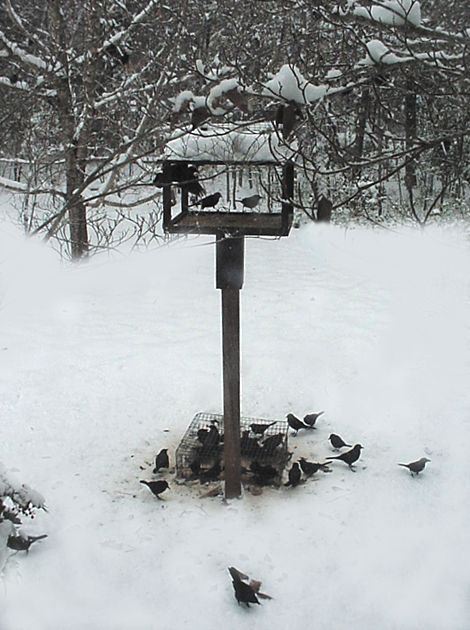
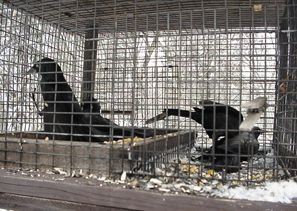 Shortly after the blackbirds arrived, we scattered them temporarily by venturing outside to place a large walk-in trap at the base of each of three platform feeders (top photo). Then we piled our favorite mix of white millet, cracked corn, whole corn, and black sunflower seeds inside the traps and went back indoors to await the flock's return. It only took a minute or two for the first birds to descend from the treetops--hunger appears to be a very strong stimulus in birds--and that's when the frantic fun began.
Shortly after the blackbirds arrived, we scattered them temporarily by venturing outside to place a large walk-in trap at the base of each of three platform feeders (top photo). Then we piled our favorite mix of white millet, cracked corn, whole corn, and black sunflower seeds inside the traps and went back indoors to await the flock's return. It only took a minute or two for the first birds to descend from the treetops--hunger appears to be a very strong stimulus in birds--and that's when the frantic fun began.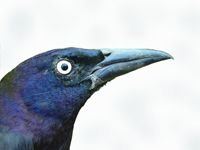 We weren't interested in pastries, of course, and merely wanted to place bands on these birds; thus, we went out to remove our captures from the traps, placing each bird in its own private compartment in a holding cage. Then we brought them all inside to begin the measuring, identification, and banding process.
We weren't interested in pastries, of course, and merely wanted to place bands on these birds; thus, we went out to remove our captures from the traps, placing each bird in its own private compartment in a holding cage. Then we brought them all inside to begin the measuring, identification, and banding process.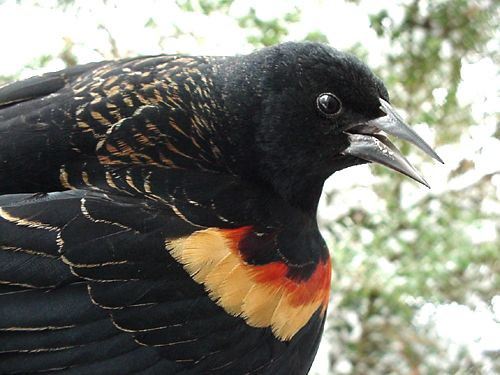

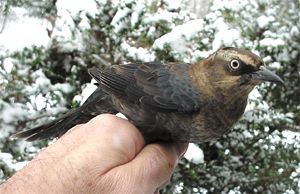 One look at the head of a wintering Rusty Blackbird (above) delights the human observer with nearly infinite shades of subtle brown and rust, plus a bright yellow eye centered in a facial patch that is usually black in males, gray in females. In its winter plumage, the Rusty Blackbird may not provide the same ebony-ivory contrast against the snow as a grackle or a male red-wing, but surely a bird this elegant ought not be persecuted for its occasional raid on agricultural crops or residential areas in Canada and the U.S.
One look at the head of a wintering Rusty Blackbird (above) delights the human observer with nearly infinite shades of subtle brown and rust, plus a bright yellow eye centered in a facial patch that is usually black in males, gray in females. In its winter plumage, the Rusty Blackbird may not provide the same ebony-ivory contrast against the snow as a grackle or a male red-wing, but surely a bird this elegant ought not be persecuted for its occasional raid on agricultural crops or residential areas in Canada and the U.S.
 Oct 15 to Mar 15:
Oct 15 to Mar 15: